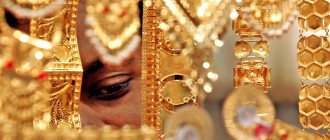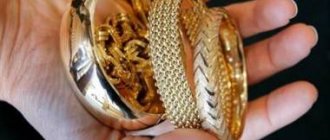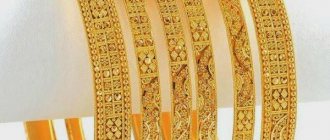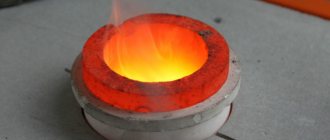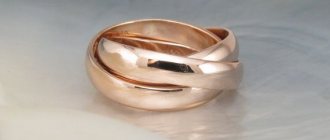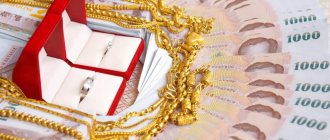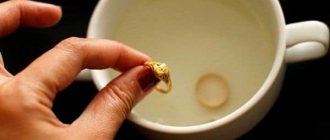Does gold rust? You can find out the scientifically based answer. Thank you. and got the best answer
Answer from Egor Akhryapin [guru] Rust is a metal oxide (or a mixture of oxides) In air, gold does not change its color and does not interact with oxygen even when heated to 400 ° C. Under normal conditions, the surface of gold is covered with a thin adsorbed layer of oxygen, however, even when heated, gold does not combine directly with oxygen, but also with sulfur and selenium. Au2O oxide and Au2O3 oxide can only be obtained indirectly. Conclusion: gold does not rust!
Reply from MAX
[guru] Unless metal also oxidizes over time... Therefore, you can notice that gold becomes dull, does not shine as brightly, etc., etc.
Reply from PASHTET (Pasha888)
[guru] No, because under normal conditions, at an average of 25 degrees Celsius, it does not oxidize like Iron
Answer from AlexChem
[expert] Definitely - gold does not rust! and does NOT oxidize. under normal conditions, as the previous speaker noted.
Answer from Vadim Kotov
[guru] What does rusting mean? This is what they say only about hardware. Even nickel and cobalt are said to oxidize in air. Copper also oxidizes in air and in some cases, in the presence of moisture, the protecting metal is covered with a noble patina from further oxidation and destruction. Gold practically does not oxidize in air, although indirectly it is possible to obtain reddish oxide and violet gold oxide. In general, with the help of fluorine, gold can be oxidized to its ultimate 8-valence state. Recently, a 7-valence gold compound was obtained for the oxidation of some difficult-to-fluorinated compounds with fluorine. In general, with the help of photonuclear reactions occurring inside the melt with the help of an arc burning inside the melt, for example, inside iron, it is possible to obtain gold through lanthanide compression, but it is better to use tin, lead, and mercury for this purpose. This problem was dealt with by the little-known professor Bolotov back in the Union.
Answer from Dmitry D.
[guru] what the hell oxidizes if gold occurs in nature in the form of nuggets or gold dust. What do you think miners are mining? It lies there for millions of years - and nothing!
Reply from VD
[master] Gold does not “rust” because it does not interact with oxygen. A does not interact with oxygen, because the valence electrons occupy states in it that are more favorable in terms of energy than if they went to oxygen. But in hardware it’s the other way around. So it's all about the electronic structure.
Answer from Alekx KU
[guru] a chemically inactive, stable precious metal, like all metals, has the property of oxidizing (rust oxides) in order to oxidize it requires a condition, in the natural environment (conditions) oxidation, as well as oxide reduction, does not occur, energetically unfavorable processes (balanced) enthalpy does not change so much so that there is a shift (direction) of the process
There is still a heated discussion on the Internet about the situation at the Mint in St. Petersburg, when rust suddenly began to appear on the “St. George the Victorious” gold coins issued by this yard. Scandal, what can I say! What? And they steal here!?
"Yes!" — German Sterligov, a well-known Russian businessman and public figure, said on the Dozhd TV channel.
Is gold really an inflation hedge?
One of the main arguments for owning precious metals, especially physical gold, is that it provides an effective hedge against inflation. However, is this still the case today?
The chart below shows the price of gold excluding inflation and key events throughout history.
The adoption of the "gold standard" by the United States is crucial to the argument that gold is an effective hedge against inflation.
The gold standard is a monetary system in which a country's currency, or paper money, has a value directly tied to gold. Under the gold standard, countries agreed to convert paper money into a fixed amount of gold. A country on the gold standard sets a fixed price for gold and buys and sells gold at that price. This fixed price is used to determine the value of the currency. For example, if the US sets the price of gold at $500 an ounce, the value of a dollar would be 1/500th of an ounce of gold.”
Investopedia
As you can see in the chart above, prices remained stable until President Nixon ended the US gold standard.
However, for this analysis, the question is, is the gold metal a good hedge against inflation? In short, the answer is both “yes” and “no”.
Timing is everything
It always depends on when you start, as with everything related to investing. Stock market investors who started when prices were low fared much better than those who started high. (This is a lesson many Gen Z and Millennials in the investment crowd will come to learn.)
The chart below shows $1 invested in gold (not adjusted for inflation) and "inflation" as measured by the Consumer Price Index.
It's easy to see that the precious metal has outperformed inflation over time. However, this is only true if you bought gold before 1980, between 2002 and 2013, or in 2021. If you bought gold outside of these periods, you lost money due to inflation.
The following chart makes this concept easier to understand by showing the difference in annual rate of change and inflation.
There is always an “opportunity cost” for every investment. There is nothing wrong with having gold in your investment portfolio unless other assets, in this case we'll use the S&P 500 stock index, provide better returns.
Currently, with an influx of $120 billion per month from the Federal Reserve, the stock market provides higher investment returns than owning gold. Therefore, market participants prefer to own ether assets due to the belief in “insurance against losses” rather than hard assets.
Will this “psychology” change over time? Absolutely.
However, the question is how many “missed opportunities” were there in the process?
This is an assessment that each investor will have to make for himself to determine whether it meets his investment goals and objectives.
What to do if your coins are covered with “rust”?
The first thing you need to do is calm down. Your coin is completely genuine and contains exactly as much precious metal as stated.
There is really nothing wrong with these stains; they are superficial, easily removed with simple chemicals, and have virtually no effect on the sample.
Head of Precious Metals Department at Ak Bars Bank Azat Salyakhutdinov
Stains can be removed. It’s just not recommended to do this yourself; without the proper experience and knowledge, you can only aggravate the situation, which will lead to a real decrease in the value of the coin. It is best to contact a jewelry workshop, where the coin will be cleaned quickly and safely. The average cost of the cleaning procedure for one golden Victorious is 50-100 rubles.
You can leave the coin in the same condition. Most investors already know about the causes of the problem and do not focus on it. And the difference in price between a “normal” and a “defective” coin is 200-300 rubles. And sometimes it’s not there at all.
First of all, I decided to go to Sberbank
and find out why such
spots appeared on gold coins
, and whether they would accept the coin for purchase.
There is a large stain near the letter “I”, as well as other stains are visible along the edge of the coin.
The savings bank said that they would accept the coin without questions. not a hindrance, because the Central Bank issued an order in which coins with spots are equated to coins in excellent condition. The main thing is that there are no stains on the coin. Another important thing: At the price of gold, they only buy Pobedonostets and Sochi rectangular ones, the rest are considered not investment. And for my 50 ruble coin 2015 Sochi Hockey, I was offered 16,500 rubles, which is currently lower than the price of the metal in the coin (7.78g * 2600r = 20,228r - the price of the metal). Therefore, there is no point in handing it over to the savings bank for purchase.
On the origin of stains on gold coins
I was told that this was a technological problem.
Theory 1:
I'm happy with my trip to Sberbank. But she continued the investigation. On the Internet I came across a very interesting version, it says that the appearance of such spots on gold coins
, may be due to the fact that at the Mint, the stamp with which the coin is minted is not completely cleaned, and that particles of other metals remain on it. These very particles are imprinted into gold coins, and it is precisely these metals that remain on the surface of the gold coin that are oxidized, resulting in stains similar to rust appearing. This theory is quite interesting, I think it has its merits.
In order to be 100% sure and dispel any doubts, I will take this coin to a special laboratory, where they will analyze its composition. In order to make sure of the purity of the metal and that the coin really consists exclusively of 999 fine gold, we submit the coin for examination, where X-ray spectral and fluorescent analysis is carried out on it. This method is used to determine the concentration of elements in substances of various origins. Performs accurate measurements at high speed. It is based on the collection and subsequent analysis of the spectrum that appears when the material under study is irradiated with X-ray radiation. I would like to note that this method of determining precious metals does not destroy or damage the coin. The instrument error is up to 0.5%. Such an analysis is carried out in few places; for those who are interested, it can be carried out at the State Historical Museum for a certain amount of money. So, the analysis showed that the purity of the metal is 24 carats, which is the maximum purity, the gold content is 100%, with an error of 0.3%, that is, the Mint, the Central Bank and Sberbank are not deceiving us
, in this case, it is not an impurity or dirty metal, but pure 999-carat gold.
Theory 2:
In the process of our little “investigation,” we talked with one of the managers of one of the largest jewelry factories in Moscow, which produced gold medals of the appropriate standard for the 2014 Olympic Games. He confirmed the formation of orange dots on gold. It was revealed that it was not the metal that was to blame, but the plastic capsules in which these medals were placed. After detecting "rust" on gold
, the jewelers took the medals out of the capsules, washed them with a special chemical solution, the stains came off, they packed them back, and after just three days the stains appeared again.
In my case, there is no marking on the capsule, the manufacturer is unknown, so we cannot exclude the possibility that plastic capsules are to blame for the stains on the gold coins
. Cleaning the coin, unfortunately, is not possible, since the coin is of PROOF quality and will be hopelessly damaged because it will lose its shine.
However, Sberbank will buy this coin even with stains (for them, stains on gold coins
not an indicator, since the Central Bank ordered Sberbank to accept coins with these spots), but Sberbank will buy them at the price indicated in their price list, in my case it is 16,500 rubles, but this is not profitable for me, since the price itself There is currently more metal than the price in the Sberbank price list.
I found sites on the Internet that buy gold coins at metal prices, so if you urgently need money, it is more profitable to sell a coin there. They also accept gold coins with spots
.
The anonymous components of gold alloys determine not only the color of the metal. The durability of the jewelry largely depends on them. It is a myth that gold does not rust. Another thing is that the presence of silver, palladium or platinum in the alloy gives it additional durability. Base metals, on the contrary, make it an order of magnitude more vulnerable.
The most common manifestation of corrosion is the darkening of gold. But there are also more dramatic cases. It happens that wedding rings literally fall apart. By the way, at all times this was considered a bad omen and foreshadowed the inevitable collapse of the marriage. Chains break even more often - especially at the junction points.
Corrosion accelerates noticeably if the product is placed in an unfavorable environment. The active corrosive medium is ordinary human sweat. In addition, red wine is on the “black list”. It has long been noted that this drink is capable of rapidly dissolving the layer of gilding on church bowls. And finally, various detergents. Surfactants, which are certainly present in their composition, can be destructive for any jewelry.
But the main reason for the rapid corrosion of jewelry is technological violations during its production. An arbitrary change in the chemical composition of the alloy, the presence of foreign impurities in it, with almost one hundred percent probability deprives gold of its durability.
The best samples of the mineral
Gold's correlation with Fed policy
As noted, there are certainly significant concerns about the Fed's continued currency interventions. Michael Lebowitz previously wrote:
“Linking real rates to central bank regulation forms the basis on which we can look at the value of the dollar through the lens of gold. The first chart below shows that gold is trending similar to the monetary base.”
The next set of scatterplots (a mathematical diagram depicting the values of two variables as points on a Cartesian plane) is more convincing. They tell the story of how the price of a precious metal became increasingly correlated with real yields as they declined. In other words, gold's rise is more positively correlated with the size of the Fed's impact.
Three scatterplots break down the relationships across three time horizons, as shown below.
The following chart shows that over the period 1982-2007, real returns averaged +3.73%. An R-square of 0.0093 shows no correlation.
The second chart concerns financial crisis-related quantitative easing, 2008-2017. During this period, real returns averaged +0.77%. The R-squared of 0.3174 shows a moderate correlation.
The latest chart covers the period after the Fed began shrinking its balance sheet and then sharply expanded it at the end of 2019. During this period, real returns averaged +0.00%, with many instances of negative real returns. An R-square of 0.7865 shows a significant correlation.
The chart says that the issue is not the price of gold per se, but its close connection with destructive fiscal and monetary policies.
If the product is new
If the blackened metal was purchased recently, then the change in color indicates its low quality. When preparing the alloy, gold is “diluted”:
- Silver.
- Nickel.
- Copper.
Blackened gold ring
Pure gold is not used to make jewelry because the metal is very ductile. Impurities will help increase its strength, so copper, nickel, silver and other metals that oxidize are added to jewelry.
If the amount of other metals in the alloy is greater than normal, then the jewelry may darken for no apparent reason.
You should get rid of such jewelry as soon as possible, take it to the store and return it under warranty, since the quality of the jewelry is questionable.
It is recommended to buy products that have a sample of 585 and 750.
The golden "trade in fear"
conclusion can be drawn from this article.
:
Fear
.
Investors tend to buy "hard assets" when there is a "fear" of rising debt, inflation, a falling dollar, a recession, or a market crash.
So let's go back to the "original" question: "What's wrong with gold?"
Absolutely nothing
. Except there is currently no “fear” to drive investors into the psychological “safe haven” of gold. This lack of fear manifests itself in everything:
- Record issue of money, losing IPO.
- Massive SPAC issue.
- Record levels of margin debt.
- Shares close to record prices.
- Private investors who take out personal debt to invest.
- Bitcoin.
- Investors' faith in the FED Put.
Do you get the idea?
But is this really so?
A very serious investigation was carried out and everything was resolved in the most prosaic way. It turns out that this is a matter of imperfection, or rather, a violation of technology. Part of the metal shavings, literally microns, as a result of non-compliance with technology, fell on the surface of the coins. Over time, this “gold” began to become stained.
But, strictly speaking, this is not the first time investors have encountered such behavior of gold coins. From time to time, the press services of banks report the indignation of their clients who, after a year of storing their gold coins in safe deposit boxes, suddenly take them out with “rusty stripes.” Such cases were noted by employees of North-West Sberbank and Khanty-Mansiysk Bank.
As for the defects themselves, it must be said that this problem is not new. Periodically, individual batches of coins appear, on the surface of which, after 2-3 years (depending on storage conditions), various turbidities, changes in color or reflective properties appear. All of these changes are nothing more than a manufacturing defect, and a superficial one at that. The reasons for its appearance most likely lie in the ingress of foreign chemical impurities onto the surface of the stamp, possibly during its cleaning, although more detailed information could probably only be provided by mint technologists.
Head of Operations in Financial Markets at Rus-Bank Stanislav Filippov
The situation is very unpleasant, so banks try not to advertise such incidents. The main thing is that our main bank, Sberbank, recognizes the problem, accusing its partners of wanting to “not wash dirty linen in public.”
A variety of reasons have been put forward. The above production errors are obvious. But it turns out that some people believe that:
- Considering the state of the atmosphere and its influence on everything around, after 5 years the storage of traces on the “gold” still cannot be avoided;
- We just don’t wash our hands well, and sweat contains urea and fat, which have a detrimental effect on the surface of coins;
- Storage conditions are not clean enough.
On the other hand, if we consider the chemistry of all processes, and after all, “George the Victorious” was produced from gold of the 999th, highest standard, then in principle the given reasons should not exist. If a gold coin leaves the Court in perfect condition, it should remain that way for centuries.
All this talk about sweat, urea and fluoride in toothpaste is just a simple excuse and a desire to cast a shadow over the fence.
Yes, cyanide compounds, bromine, and mercury affect gold, but God forbid we encounter them in everyday life; it would not be enough for our hands to be in mercury.
Scientifically speaking, patina and gold are completely incompatible things. If there is a patina, then the problem is with the gold, and not in some mythical reactions “from the press services of banks.”
On the other hand, there is no doubt - if it is announced that the 999th sample was used in production, then this is so.
There is only one conclusion that all bankers come to, albeit reluctantly: rust is a consequence of errors in the manufacturing process. We started with this, reasoned and weighed all the opinions, made a circle, and came to the same thing. You can’t say: “They’re stealing, gentlemen!” (even at the Mint!). But the fact that they work, and here, carelessly, is beyond any doubt.
It should also be noted that although the Central Bank admitted the mistake, it is in no hurry to correct it. Although the scandal erupted back in 2010, rust on coins of the St. Petersburg Mint (SPMD) also appears on coins of 2015. To be fair, it must be said that on a much smaller scale. By the way, this is precisely what determines the slightly lower price compared to products from the Moscow Mint (MMD), where such defects were not observed.
Two main problems
When it comes to investing, people need to determine "why" they own gold?
— Is this a short-term bet on rising prices or a “psychological” transaction based on
“fear”
and
“emotions”
?
If the former, then there is nothing wrong with owning gold.
This is a product that will rise and fall in price. Given that gold has no fundamentals (earnings or dividends), the “price” of gold is all you need to know to successfully trade the metal.
The latter is more problematic. Considering that gold is no longer exchanged for currency, and vice versa, it remains a non-working link as a means of protection against inflation. In today's "paper"
monetary economics, the opportunity to use gold as a method of transaction on a global scale remains unrealized.
Thus, gold trading has become a "fear trade" due to fears of a falling dollar, inflation and an economic reboot.
While there are good reasons to be concerned about such catastrophic outcomes, these events can last for decades. For example, Japan is an example of a demographic time bomb combined with the world's highest debt-to-GDP ratio. This is the reality today, but “the bug hasn’t hit the windshield yet.”
Yes, it will happen eventually, but how long it will take is unknown.

